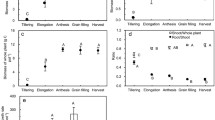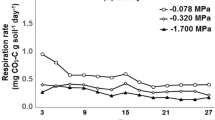Abstract
Wheat (cv. Gutha) and barley (cv. O'Connor) were grown as field crops on a shallow duplex soil (sand over clay) in Western Australia with their root systems contained within pvc columns. At four stages during growth, the shoots were pulse-labelled for 1.5h with14CO2; immediately prior to labelling, the soil was isolated from the shoot atmosphere by pvc sheets. After labelling, the soil atmosphere was pumped through NaOH to trap respired CO2 and after 2.5, 5, 7.5 and 24 h from the start of labelling, columns were destructively sampled to recover14C from the roots, soil and shoot.
Both species showed similar patterns of14C distribution and changes in distribution through the growing season. During early tillering, 15–25% of the14C recovered after 24 h had been respired by the roots and rhizosphere, 17–27% was retained in the roots, 0.4–1.8% was recovered as water-soluble14C in the soil and the remainder (45–67%) was present in the shoot. These percentages changed during growth so that during grain filling only 2–3% of the14C recovered after 24 h was as respired CO2, 2–6% was in the roots, 0.2% was in the soil and over 90% was in the shoot.
The distribution of14C in components of the soil-plant system changed during the 24 h after labelling with the most rapid changes occurring generally during the first 7.5 h after labelling.
Using growth measurements from adjacent plots, the amounts of C added to the soil were estimated for the whole season. Carbon input to the soil was about 48 gC m−2 for wheat and 58 gC m−2 for barley; the crops produced total shoot dry matter of 494 (wheat) and 735 g m−2 (barley). Of the C input to the soil, 27.8% (wheat) and 40.3% (barley) was as respired C and only 3.3 (wheat) and 4.1% (barley) was collected as exudate (water-soluble material).
Similar content being viewed by others
References
Atwell B J 1990 The effect of soil compaction on wheat during early tillering. II. Fate of carbon transported to the roots. New Phytol. 115, 43–49.
Barber D A and Martin J K (1976) The release of organic substances by cereal roots into soil. New Phytol. 76, 69–80.
Barraclough P B 1984 The growth and activity of winter wheat roots in the field: Root growth of high-yielding crops in relation to shoot growth. J. Agric. Sci. Camb. 103, 439–442.
Brown S C, Keatinge J D H, Gregory P J and Cooper P J M 1987 Effects of fertilizer, variety and location on barley production under rainfed conditions in northern Syria. 1. Root and shoot growth. Field Crops Res. 16, 53–66.
Cheshire M V and Mundie C M (1990) Organic matter contributed to soil by plant roots during the growth and decomposition of maize. Plant and Soil 121, 107–114.
Gregory P J, McGowan M, Biscoe P V and Hunter B 1979 Water relations of winter wheat. 1. Growth of the root system. J. Agric Sci. Camb. 91, 91–102.
Gregory P J, Shepherd K D and Cooper P J M 1984 Effects of fertilizer on root growth and water use of barley in northern Syria. J. Agric. Sci. Camb. 103, 429–438.
Gregory P J, Tennant D and Belford R K (1992) Growth of roots and shoots, and water and light use efficiency of barley and wheat crops grown on a shallow duplex soil in a Mediterranean-type environment. Aust. J. Agric. Res. (Submitted.)
Hall A J, Connor D J and Whitfield D M 1990 Root respiration during grain filling in sunflower: The effects of water stress. Plant and Soil 121, 57–66.
Hamblin A, Tennant D and Perry M W (1990) The cost of stress: Dry matter partioning changes with seasonal supply of water and nitrogen to dryland wheat. Plant and Soil 122, 47–58.
Keith H, Oades J M and Martin J K (1986) Input of carbon to soil from wheat plants. Soil Biol. Biochem. 18, 445–449.
Lambers H (1987 Growth, respiration, exudation and symbiotic associations: The fate of carbon translocated to roots.In Root Development and Function. Eds. P J Gregory, J V Lake and D A Rose. pp 125–145. Cambridge University Press, Cambridge.
Martin J K 1977 Factors influencing the loss of organic carbon from wheat roots. Soil. Biol. Biochem. 9, 1–7.
Martin J K and Kemp J R (1986) The measurement of C transfers within the rhizosphere of wheat grown in field plots. Soil Biol. Biochem. 18, 103–107.
Newman E I 1985 The rhizosphere: Carbon sources and microbial populations.In Ecological Interactions in Soil: Plants, Microbes and Animal. Eds. A H Fitter, D Atkinson, D J Read and M B Usher. pp 107–121. British Ecological Society Special Publication No 4. Blackwell Scientific Publications, Oxford.
Nobel P S and Palta J A 1989 Soil O2 and CO2 effects on root respiration of cacti. Plant and Soil 120, 263–271.
Penning de Vries F W T and van Laar H H 1982 Simulation of growth processes and the model BACROS.In Simulation of Plant Growth and Crop Production. Eds. F W T Penning de Vries and H H van Laar. pp 114–135. Pudoc, Wageningen, The Netherlands.
Smucker A J M 1984 Carbon utilization and losses by plant root systems.In Roots, Nutrient and Water Influx, and Plant Growth. pp 27–46. ASA Special Publication Number 49, Madison, WI.
Weir A H, Bragg P L, Porter J R and Rayner J H 1984 A winter wheat crop simulation model without water or nutrient liminations. J. Agric. Sci. Camb. 102, 371–382.
Welbank P J, Gibb M J, Taylor P J and Williams E D 1974 Root growth of cereal crops. Rothamsted Exp. St'n Rep. 1973, pt. 2, pp 26–66.
Whipps J M 1984 Environmental factors affecting the loss of carbon from the roots of wheat and barley seedlings. J. Exp. Bot. 35, 767–773.
Wood M 1987 Predicted microbial biomass in the rhizosphere of barley in the field. Plant and Soil 97, 303–314.
Author information
Authors and Affiliations
Rights and permissions
About this article
Cite this article
Gregory, P.J., Atwell, B.J. The fate of carbon in pulse-labelled crops of barley and wheat. Plant Soil 136, 205–213 (1991). https://doi.org/10.1007/BF02150051
Received:
Revised:
Issue Date:
DOI: https://doi.org/10.1007/BF02150051




